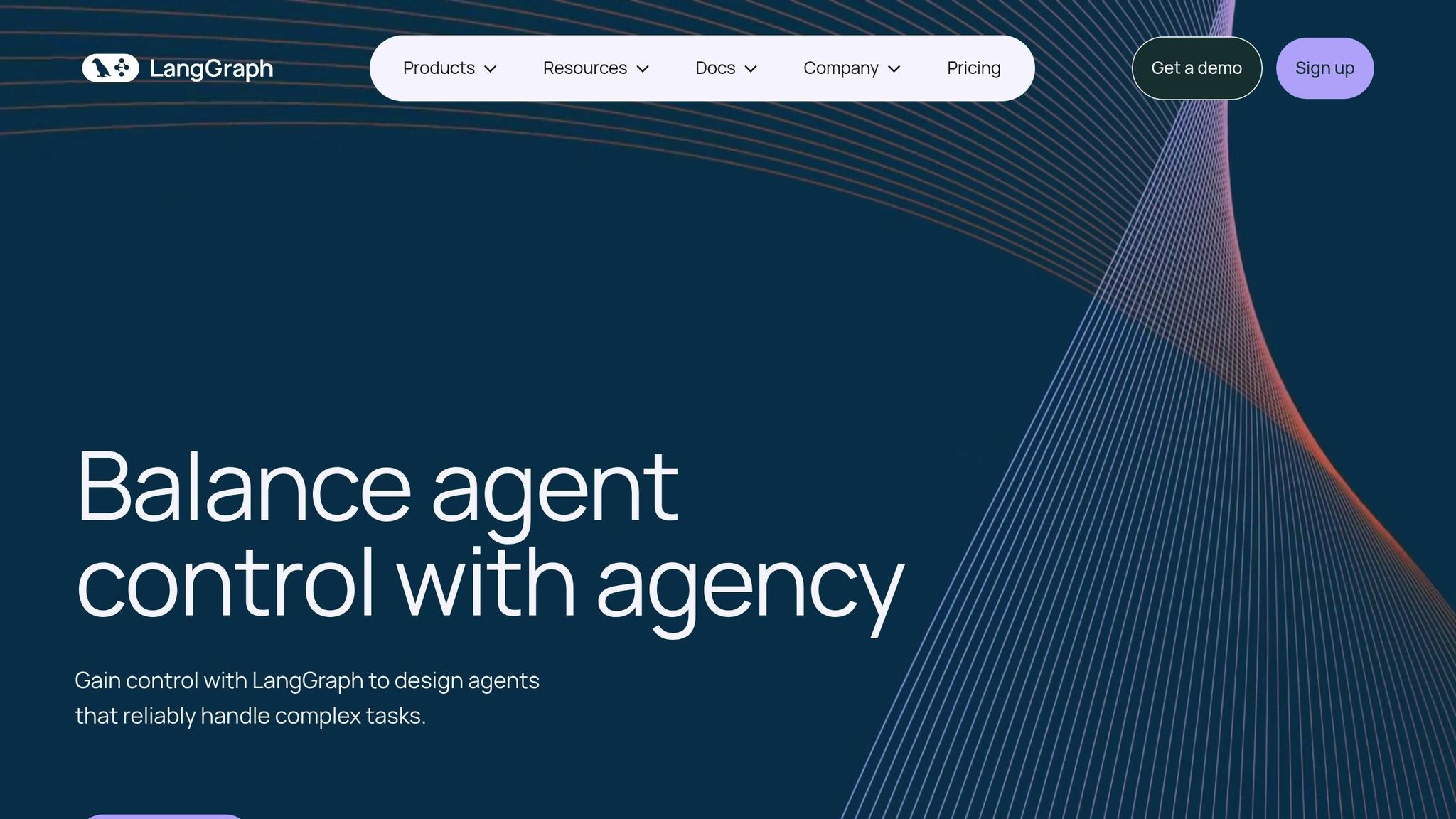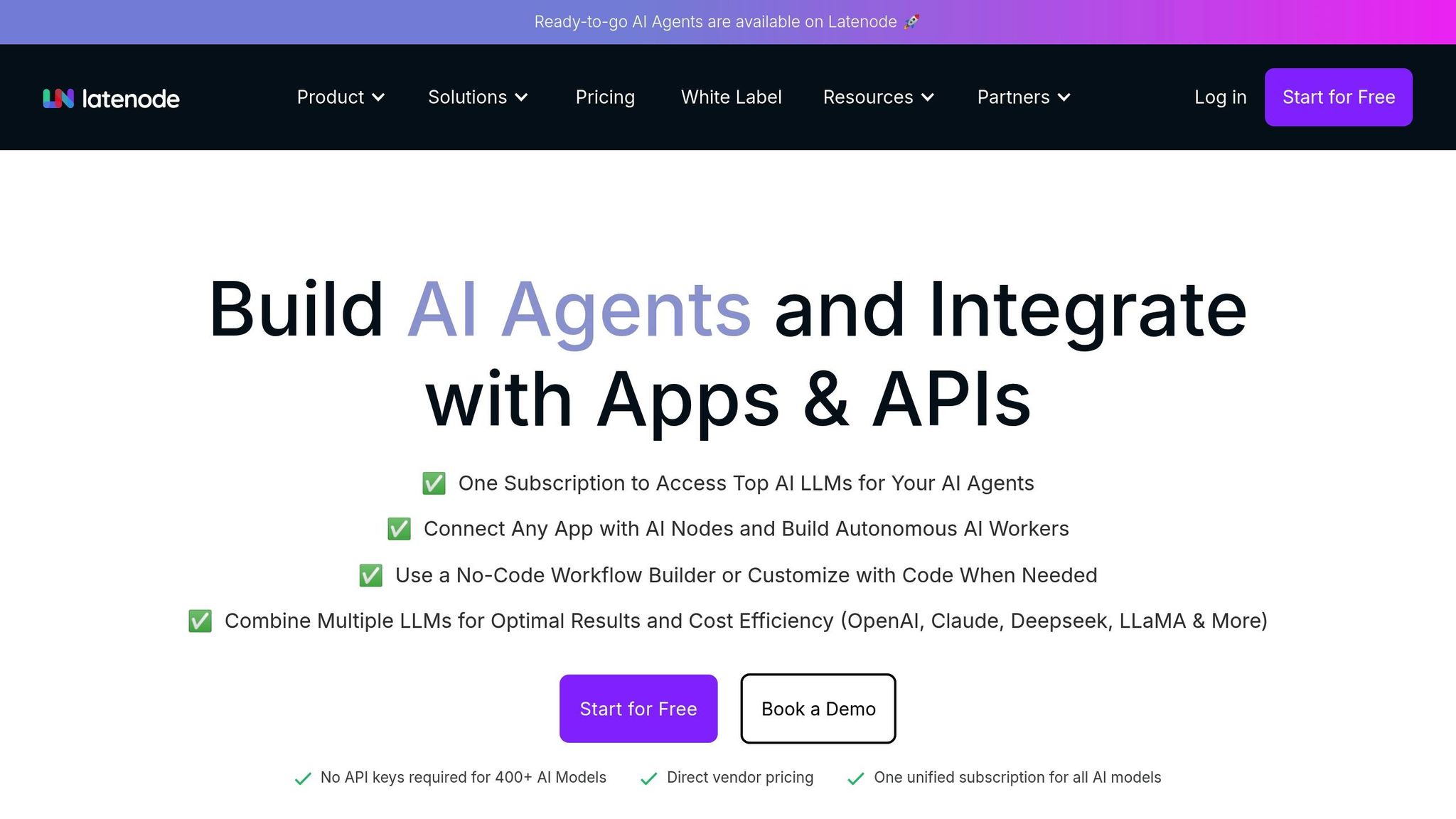


LangGraph is a Python framework designed for building stateful AI workflows using graph-based structures. Unlike linear tools, LangGraph enables workflows to adapt dynamically based on conditions, outcomes, or user inputs. Its standout features include persistent state management, multi-agent coordination, and built-in support for human oversight. These capabilities make it ideal for creating advanced applications like chatbots, collaborative systems, and conditional workflows.
LangGraph simplifies complex tasks, such as maintaining conversational context or integrating external tools. For example, a chatbot built with LangGraph can track user history, escalate issues to human agents, and generate responses based on stored context. By leveraging its graph-based approach, developers can design workflows that handle branching, loops, and error recovery efficiently.
For those seeking a low-code alternative, Latenode offers a visual-first platform that incorporates many of LangGraph’s principles, making workflow creation accessible for users without extensive coding experience. With Latenode, you can visually design workflows, manage state, and integrate over 200 AI models seamlessly. Whether you’re building chatbots, automating approvals, or coordinating multi-agent tasks, tools like LangGraph and Latenode provide practical solutions tailored to your needs.

LangGraph is a Python framework designed to streamline workflow automation, starting from basic setup to creating complex, adaptable systems.
To get started with LangGraph, you first need to set up your environment. Begin by creating a dedicated virtual environment to isolate dependencies and avoid conflicts. Open your terminal and run the following commands:
python -m venv venv
source venv/bin/activate # For macOS/Linux
# venv\Scripts\activate # For Windows
Once the virtual environment is activated, install LangGraph via pip:
pip install -U langgraph
You can confirm the installation by importing the library in a Python REPL:
import langgraph
LangGraph often requires additional dependencies for integrating with language models or external tools. For example:
langchain-openai for OpenAI models.langchain[anthropic] for Claude integration.tavily-python for web search capabilities [2][1][3][4].To securely handle API keys, store them in environment variables. For instance, set your OpenAI API key like this:
export OPENAI_API_KEY="your-api-key-here"
On Windows, replace export with set. These keys allow LangGraph to interact with external services during workflow execution [2][1][3][4].
With the environment ready and LangGraph installed, you're all set to build your first workflow.
LangGraph workflows revolve around defining and managing state, using Python's TypedDict for type-safe data handling. Here's a simple example to get you started:
from typing import TypedDict
from langgraph.graph import StateGraph, START, END
class GraphState(TypedDict):
message: str
count: int
Workflow operations are encapsulated in nodes, which process the current state and return updates as dictionaries. Each node focuses on a specific task while maintaining the overall state:
def greeting_node(state: GraphState):
return {"message": f"Hello! Processing item {state['count']}"}
def counter_node(state: GraphState):
return {"count": state["count"] + 1}
Next, initialize a StateGraph, add nodes, and define the execution order using edges:
# Initialize the graph with state schema
workflow = StateGraph(GraphState)
# Add nodes to the graph
workflow.add_node("greeting", greeting_node)
workflow.add_node("counter", counter_node)
# Define execution flow
workflow.add_edge(START, "greeting")
workflow.add_edge("greeting", "counter")
workflow.add_edge("counter", END)
# Compile the graph
app = workflow.compile()
To execute the graph, provide an initial state and invoke the compiled application:
initial_state = {"message": "", "count": 0}
result = app.invoke(initial_state)
print(result) # {'message': 'Hello! Processing item 0', 'count': 1}
This example demonstrates the core concepts of LangGraph. From here, you can expand into more advanced workflows.
State management in LangGraph goes beyond simple data passing. It ensures persistent, typed state throughout the workflow, enabling seamless coordination between operations.
Unlike stateless systems that lose context between steps, LangGraph retains state across the entire workflow lifecycle. This feature is particularly useful for applications like conversational AI or multi-step processes. For instance, you can manage a conversation's context with a TypedDict:
class ConversationState(TypedDict):
messages: list
user_id: str
context: dict
def add_message_node(state: ConversationState):
new_message = {"role": "assistant", "content": "How can I help?"}
return {"messages": state["messages"] + [new_message]}
When a node updates the state, LangGraph merges the changes with the existing data. In this example, the messages list is updated, while user_id and context remain unchanged.
State validation is built into the framework, using TypedDict schemas to catch type mismatches at runtime. This approach helps identify errors early, saving debugging time and improving reliability.
Once you're comfortable with the basics, LangGraph offers advanced patterns to handle complex scenarios like conditional branching, loops, error handling, and human-in-the-loop workflows.
Conditional Branching
You can create dynamic workflows that adapt based on state conditions. For example:
def should_escalate(state: ConversationState):
if state.get("confidence_score", 0) < 0.7:
return "human_agent"
return "ai_response"
workflow.add_conditional_edges(
"analyze_query",
should_escalate,
{"human_agent": "escalate", "ai_response": "respond"}
)
Cyclic Flows
Workflows can loop back to previous nodes for iterative processing or retries. This is useful for tasks requiring multiple attempts:
def check_quality(state: TaskState):
if state["attempts"] < 3 and state["quality_score"] < 0.8:
return "retry"
return "complete"
workflow.add_conditional_edges(
"quality_check",
check_quality,
{"retry": "process_task", "complete": END}
)
Human-in-the-Loop Workflows
Incorporate human oversight at key decision points. For instance:
workflow.add_node("human_approval", human_approval_node)
workflow.add_edge("generate_response", "human_approval")
workflow.add_conditional_edges(
"human_approval",
lambda state: "approved" if state["approved"] else "rejected",
{"approved": "send_response", "rejected": "revise_response"}
)
Error Handling
LangGraph supports robust error handling with try-catch patterns and conditional routing for recovery:
def safe_api_call(state: APIState):
try:
result = external_api.call(state["query"])
return {"result": result, "error": None}
except Exception as e:
return {"result": None, "error": str(e)}
These advanced techniques allow for the creation of adaptable, real-world workflows, transforming simple processes into powerful systems.
LangGraph projects bring theoretical concepts to life by transforming them into practical business applications. These examples build on the foundational LangGraph tutorial, showcasing how to apply its patterns in real-world scenarios.
A support chatbot that remembers conversation history can enhance user interactions significantly. By combining LangGraph's state management with external tools, you can create a chatbot that maintains context across multiple exchanges while accessing a mock knowledge base.
Here’s how to get started:
The chatbot's state should capture key details like conversation history, user context, and tool outputs. Here's an example:
from typing import TypedDict, List, Optional
from langgraph.graph import StateGraph, START, END
from langchain_openai import ChatOpenAI
class ChatbotState(TypedDict):
messages: List[dict]
user_id: str
conversation_id: str
knowledge_base_results: Optional[str]
escalation_needed: bool
confidence_score: float
Create a function to retrieve relevant information based on user queries:
def search_knowledge_base(query: str) -> str:
# Simulate a knowledge base search
knowledge_items = {
"password": "To reset your password, click 'Forgot Password' on the login page.",
"billing": "Billing issues can be resolved by contacting our finance team at billing@company.com.",
"technical": "For technical support, please provide your system specifications and error details."
}
for key, value in knowledge_items.items():
if key in query.lower():
return value
return "I couldn't find specific information about your query."
def knowledge_search_node(state: ChatbotState):
last_message = state["messages"][-1]["content"]
results = search_knowledge_base(last_message)
return {"knowledge_base_results": results}
Combine the conversation history and knowledge base results to craft more personalized replies:
def generate_response_node(state: ChatbotState):
llm = ChatOpenAI(model="gpt-3.5-turbo", temperature=0.7)
context = f"Knowledge base info: {state.get('knowledge_base_results', 'No specific info found')}"
conversation_history = "".join(
[f"{msg['role']}: {msg['content']}" for msg in state["messages"][-3:]]
)
prompt = f"""
You are a helpful support assistant. Use the following context and conversation history to respond:
Context: {context}
Recent conversation:
{conversation_history}
Provide a helpful, concise response. If you cannot help, suggest escalation.
"""
response = llm.invoke(prompt)
confidence = 0.8 if state.get('knowledge_base_results') != "I couldn't find specific information about your query." else 0.4
new_message = {"role": "assistant", "content": response.content}
return {
"messages": state["messages"] + [new_message],
"confidence_score": confidence,
"escalation_needed": confidence < 0.5
}
Set up conditional routing to determine if escalation to a human agent is necessary:
def should_escalate(state: ChatbotState):
return "escalate" if state.get("escalation_needed", False) else "complete"
def escalation_node(state: ChatbotState):
escalation_message = {
"role": "assistant",
"content": "I'm connecting you with a human agent who can better assist you."
}
return {"messages": state["messages"] + [escalation_message]}
Bring it all together with LangGraph’s workflow capabilities:
workflow = StateGraph(ChatbotState)
workflow.add_node("knowledge_search", knowledge_search_node)
workflow.add_node("generate_response", generate_response_node)
workflow.add_node("escalate", escalation_node)
workflow.add_edge(START, "knowledge_search")
workflow.add_edge("knowledge_search", "generate_response")
workflow.add_conditional_edges(
"generate_response",
should_escalate,
{"escalate": "escalate", "complete": END}
)
workflow.add_edge("escalate", END)
chatbot = workflow.compile()
# Test the chatbot with a sample conversation
initial_state = {
"messages": [{"role": "user", "content": "I can't remember my password"}],
"user_id": "user_123",
"conversation_id": "conv_456",
"knowledge_base_results": None,
"escalation_needed": False,
"confidence_score": 0.0
}
result = chatbot.invoke(initial_state)
print(result["messages"][-1]["content"])
# Expected output: "To reset your password, click 'Forgot Password' on the login page. You can find this option on the main login screen..."
LangGraph also supports workflows where multiple agents collaborate on complex tasks. A content creation workflow, for instance, can involve agents specializing in research, writing, and editing.
Track the progress of the content creation process with a shared state structure:
from typing import TypedDict, List
class ContentCreationState(TypedDict):
topic: str
research_data: List[str]
draft_content: str
edited_content: str
current_agent: str
quality_score: float
revision_count: int
Assign distinct roles to agents for different stages of the workflow:
def research_agent(state: ContentCreationState):
# Perform research
research_results = [
f"Key insight about {state['topic']}: Market trends show increasing demand",
f"Statistical data: 73% of users prefer {state['topic']}-related solutions",
f"Expert opinion: Industry leaders recommend focusing on {state['topic']} benefits"
]
return {
"research_data": research_results,
"current_agent": "research_complete"
}
def writing_agent(state: ContentCreationState):
llm = ChatOpenAI(model="gpt-4", temperature=0.8)
research_summary = "".join(state["research_data"])
prompt = f"""
Write an article about {state['topic']} using this research:
{research_summary}
Create informative content that incorporates the key insights.
"""
response = llm.invoke(prompt)
return {
"draft_content": response.content,
"current_agent": "writing_complete"
}
def editing_agent(state: ContentCreationState):
llm = ChatOpenAI(model="gpt-4", temperature=0.3)
prompt = f"""
Edit and improve this content for clarity, flow, and engagement:
{state['draft_content']}
Focus on:
- Clear structure and transitions
- Professional tone
- Factual accuracy
"""
response = llm.invoke(prompt)
quality_score = 0.85 if len(response.content) > len(state["draft_content"]) * 0.8 else 0.6
return {
"edited_content": response.content,
"quality_score": quality_score,
"current_agent": "editing_complete"
}
Introduce logic to evaluate and refine the output:
def quality_check(state: ContentCreationState):
if state["quality_score"] < 0.7 and state["revision_count"] < 2:
return "revise"
return "complete"
def revision_coordinator(state: ContentCreationState):
return {
"current_agent": "revision_needed",
"revision_count": state["revision_count"] + 1
}
LangGraph’s flexibility allows for seamless integration of such multi-agent workflows, ensuring tasks are completed efficiently while maintaining high-quality outcomes.

LangGraph offers a deep dive into graph-based AI architecture, but not every developer wants to wrestle with the complexities of graph programming. For those seeking a more intuitive approach, visual development platforms like Latenode provide a way to create stateful workflows without extensive coding expertise. This comparison highlights how visual tools can simplify and accelerate AI workflow automation.
The distinction between Latenode and LangGraph lies in their approach to building AI workflows. LangGraph takes a code-first route, requiring developers to explicitly define states, nodes, and edges. This can be daunting for those new to the field. Latenode, on the other hand, adopts a visual-first philosophy. Its drag-and-drop interface allows users to design sophisticated workflows without writing large amounts of code, making tasks like creating a chatbot with memory far more accessible.
Debugging and Maintenance
Code-based systems often demand meticulous tracking of execution paths, which can become increasingly complex as workflows grow. Latenode simplifies this process with its visual interface, offering real-time views of execution history and data flow between nodes. This makes debugging and ongoing maintenance more straightforward.
Learning Curve Comparison
Code-first frameworks like LangGraph require a solid understanding of programming and data structures, which can be a barrier for beginners. Latenode removes this hurdle by letting users focus on workflow logic instead of syntax. While LangGraph offers flexibility for seasoned developers, Latenode prioritizes simplicity and speed, enabling users to get functional AI workflows up and running quickly.
By translating LangGraph's core concepts into a visual format, Latenode makes workflow creation more approachable while maintaining the principles of stateful AI design.
Latenode incorporates many of the foundational ideas from LangGraph - such as state management, conditional routing, and multi-agent task orchestration - into its user-friendly visual framework:
This visual representation of key principles ensures that even complex AI workflows remain accessible and easy to manage.
Quick Start for New Users
Latenode enables beginners to create production-ready workflows almost immediately. By focusing on workflow design rather than programming syntax, users can turn ideas into working solutions with minimal delay.
Seamless AI Integration
Latenode connects directly to over 200 AI models and handles API tasks automatically, removing the need for manual integration.
Enhanced Collaboration
The visual nature of Latenode makes workflows easier to understand and review. Non-technical team members and stakeholders can participate in the development process without needing to dive into code.
Effortless Scalability
With built-in database and browser automation capabilities, Latenode scales smoothly from initial experiments to full-scale production, all without adding unnecessary complexity.
Taking your LangGraph projects further involves scaling, refining, and deploying them as robust, production-ready applications. Here's how to approach this next phase effectively.
As your LangGraph applications expand in both user base and complexity, ensuring smooth performance becomes essential. One key area to focus on is memory management. Instead of retaining entire conversation histories, consider compressing older interactions and keeping only the most recent exchanges readily accessible. This helps maintain efficiency without sacrificing context.
Another important step is database integration. Transitioning from in-memory storage to a database-backed solution allows you to manage memory usage more effectively. It also transforms your workflows from temporary experiments into reliable, persistent applications.
For improved performance, parallel processing can enable multiple agents to operate simultaneously. Additionally, implementing error-handling mechanisms like exponential backoff and circuit breakers can help prevent cascading failures and maintain system stability under stress.
By implementing these optimizations, you’ll set a strong foundation for advanced learning and production-ready applications.
To deepen your understanding, the official LangGraph documentation (langchain-ai.github.io/langgraph) is an invaluable resource. It offers detailed API references, architectural guidelines, and practical examples covering topics like state persistence, human-in-the-loop workflows, and multi-agent coordination.
The LangGraph GitHub repository is another excellent source of inspiration. It features a range of example projects, from simple chatbots to sophisticated research assistants, showcasing how companies use LangGraph to build scalable AI applications.
For additional support, explore online communities and YouTube channels dedicated to LangGraph. These platforms often provide real-time advice and in-depth tutorials on advanced patterns.
Once your workflows are optimized, the next step is deploying your application in a secure and scalable environment. Start by configuring your system to handle API rate limits and manage tokens effectively through pooling and monitoring. Tools like Prometheus or Grafana can provide real-time system insights, while strict security measures - such as input sanitization, output filtering, and encrypted state storage - help protect your application.
For teams looking to streamline deployment, Latenode offers a powerful solution. Its visual platform simplifies the complexities of production environments with built-in features like automatic scaling, real-time monitoring, and integrated database management. Supporting over 300 app integrations and 200+ AI models, Latenode provides ready-to-use components that can accelerate your journey from concept to deployment.
With Latenode, you can implement advanced techniques and create production-ready workflows without compromising on sophistication. This AI orchestration platform allows you to focus on refining your application logic while handling the infrastructure challenges seamlessly.
LangGraph's graph-based framework introduces a new level of flexibility for AI workflows by supporting non-linear processes such as loops, conditional branching, and multi-agent collaboration. Unlike traditional linear tools that follow a rigid, step-by-step sequence, LangGraph enables workflows to adjust dynamically based on real-time inputs and intricate requirements.
This design is particularly effective for building modular, scalable, and persistent workflows, simplifying the management of advanced AI tasks like multi-step interactions, human-in-the-loop operations, and maintaining state across processes. With this dynamic approach, LangGraph equips developers to create smarter, more adaptive AI systems that can meet evolving demands with precision.
LangGraph excels at managing conversational context in chatbots, thanks to its stateful memory features. This capability enables chatbots to recall prior interactions, sustain context over multiple exchanges, and efficiently manage intricate, multi-step workflows.
With persistent state management and dynamic context windows, LangGraph fosters conversations that feel more fluid and natural. It addresses the challenges of traditional linear methods, delivering a more seamless and engaging experience for users interacting with chatbots.
Beginners can quickly dive into creating AI workflows using Latenode, thanks to its intuitive no-code platform. The platform’s visual interface lets users design workflows by dragging and dropping components, removing the need for any advanced coding skills.
With access to over 300 pre-built integrations, Latenode streamlines the process of connecting tools and automating tasks. This setup makes it simpler and faster to develop stateful AI applications. By focusing on usability, Latenode allows users to explore and apply AI concepts without getting bogged down in complex trial-and-error, paving the way for faster deployment of effective solutions.



